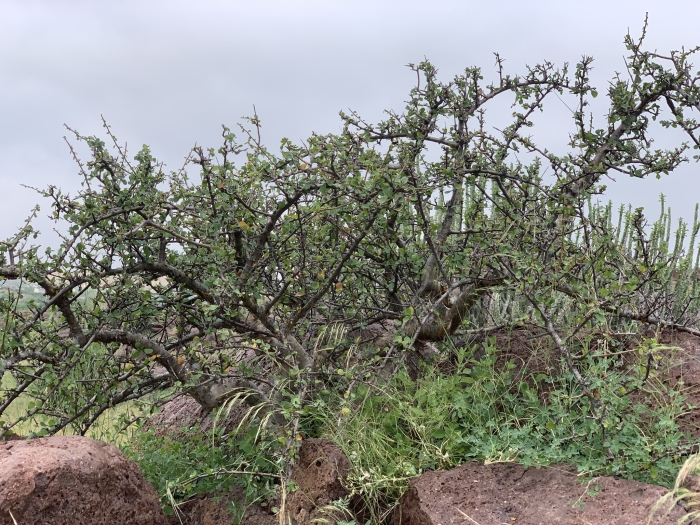Indian Bdellium-Tree
(Commiphora wightii)
Indian Bdellium-Tree (Commiphora wightii)
/
/

© divyacm
CC BY-SA 4.0
Image By:
© divyacm
Recorded By:
Copyright:
CC BY-SA 4.0
Copyright Notice:
Photo by: © divyacm | License Type: CC BY-SA 4.0 | License URL: http://creativecommons.org/licenses/by-sa/4.0/ | Uploader: divyacm | Publisher: iNaturalist |












Estimated Native Range
Summary
Commiphora wightii, commonly known as the Indian bdellium-tree or guggul, is a deciduous shrub or small tree native to arid and semi-arid regions, particularly the rocky tracks in the arid zones of Rajasthan, Gujarat, and Karnataka in India, as well as in southern Pakistan. It typically grows up to 13 feet tall and has a spread of 3 to 4 feet. The plant has a distinctive appearance with thin, papery bark that peels off in flakes, thorny branches, and a sparse canopy. It produces small, unisexual flowers that are red to pink, blooming from November to January. The flowers are not particularly showy, but the plant is well-known for its aromatic gum resin, which exudes from the bark.
The guggul resin, which has a balsamic fragrance, is highly valued for its use in incense and traditional Ayurvedic medicine, where it is believed to treat a variety of ailments. In cultivation, guggul requires well-drained soil, preferably sandy or stony, and thrives in full sun with low to moderate water requirements. It is not commonly grown in gardens but may be of interest to those who practice herbal medicine or wish to contribute to its conservation. Overharvesting for medicinal use has led to its scarcity in native habitats, and it is now classified as a near-threatened species by the IUCN. Cultivation efforts are important for conservation and to reduce pressure on wild populations.CC BY-SA 4.0
The guggul resin, which has a balsamic fragrance, is highly valued for its use in incense and traditional Ayurvedic medicine, where it is believed to treat a variety of ailments. In cultivation, guggul requires well-drained soil, preferably sandy or stony, and thrives in full sun with low to moderate water requirements. It is not commonly grown in gardens but may be of interest to those who practice herbal medicine or wish to contribute to its conservation. Overharvesting for medicinal use has led to its scarcity in native habitats, and it is now classified as a near-threatened species by the IUCN. Cultivation efforts are important for conservation and to reduce pressure on wild populations.CC BY-SA 4.0
Plant Description
- Plant Type: Shrub, Tree
- Height: 6-9 feet
- Width: 4-6 feet
- Growth Rate: Slow
- Flower Color: Yellow
- Flowering Season: Spring
- Leaf Retention: Evergreen
Growth Requirements
- Sun: Full Sun, Part Shade
- Water: Low, Medium
- Drainage: Fast, Medium
Common Uses
Drought Tolerant, Low Maintenance
Natural Habitat
Arid and semi-arid regions, particularly the rocky tracks in the arid zones of Rajasthan, Gujarat, and Karnataka in India, as well as in southern Pakistan
Other Names
Common Names: Guggul, Mukul Myrrh Tree, Gugul
Scientific Names: , Commiphora wightii, Balsamea mukul, Balsamodendrum mukul, Balsamodendrum mukul, Balsamodendrum roxburghii, Balsamodendrum wightii, Commiphora mukul, Commiphora roxburghii, Commiphora roxburghii var. serratifolia,
GBIF Accepted Name: